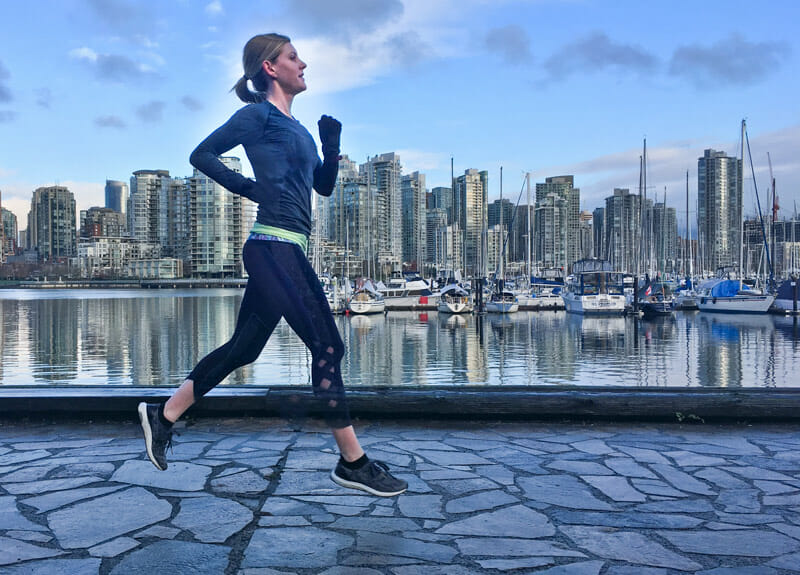How to Choose Running Shoes & Prevent Injury
It’s quickly approaching that time of year when New Year’s resolutions are starting to form, and if for you those goals include running, it’s important to start thinking about what you need to get there. Whether it’s running your first 5k, the Vancouver Sun Run or setting a new personal best, gearing yourself up for success is important, and when it comes to running, shoes should be your number one priority.
However, how do you choose the right running shoe? How do you know you need a shoe-change or if you’re ready? And what’s the best way to make the switch to prevent future injury?

Is it time to make the switch?
We’ve all heard the saying “if it’s not broke don’t fix it” right? Well I would say it only SOMEWHAT applies to running shoes. If you’re happy with your shoes, you’re  happy with your performance and don’t have, and haven’t had any foot/achilles/calf injuries then cool your jets and keep rocking your current footwear! However, if you answered NO to any of the following questions then maybe a switch-up could be helpful. The chart on the right is a useful tool from a course I took earlier in the year with the running clinic and may be helpful in deciding whether or not a shoe switch is right for you.
happy with your performance and don’t have, and haven’t had any foot/achilles/calf injuries then cool your jets and keep rocking your current footwear! However, if you answered NO to any of the following questions then maybe a switch-up could be helpful. The chart on the right is a useful tool from a course I took earlier in the year with the running clinic and may be helpful in deciding whether or not a shoe switch is right for you.
STOP RIGHT THERE! If you’re like me, then as soon as you get something new you want to wear it right away…it’s the best motivation to run right?! Well I’m sorry to be the one to curb your enthusiasm, but depending on the shoes your transitioning from and to, making the switch too quickly can lead to injury. This is due to the fact that shoes differ from one to the next in 5 key ways:
5 Key Running Shoe Differences
- Weight
- Stack height= the thickness under your foot
- Heel-to-toe drop= how much the drop is from the heel to the toe
- Stability and motion control technologies= such as anti-pronation technology
- Flexibility= longitudinal and torsional
So when you’re switching from one pair of shoes to another you have to consider the different stress your putting on your body, the different position you’re putting it in and how it’s going to adapt to these changes….this is the key point to take away, ADAPTATION! Our bodies can adapt and change as long as the rate at which we apply that change doesn’t exceed the rate at which our tissues are able to adapt to it…AKA our bodies need time!
So while there are specific formulas to follow if you’re planning on making a bigger jump, the best thing to do is listen to your body… pain means you’re progressing too fast and you need to slow down! I personally like to use the 10% rule with myself and with my clients. This means starting in your new shoes for one of your shorter runs in a week (or looped runs where you can switch them out half-way) and increasing your mileage spent in them by 10% each week. If you have any onset of pain you drop the miles by 5% and continue to progress once the pain has subsided.
Just remember, shoes aren’t magic! They can’t propel us to the top of podiums or correct for training errors; but they are one of the most important pieces of equipment we have as runners and should be chosen wisely. So remember to chose wisely, keep your goals in mind and always, always, always choose function over fashion…but fingers crossed you can satisfy both needs!
Related Posts on Injury & Rehab
-
The Difference Between a Strain vs Sprain
-
Tips to Foam Rolling for Training & Running
-
Injury Rates & Gender Differences in Runners
-
Common Running Injuries & Sports Physio
-
Understanding Iliotibial Band Syndrome
-
9 Common Running Injuries that Physiotherapy can Address
Sports Physiotherapy at Burnaby PhysioCare
If you have any questions regarding a running injury or sports related injury, we invite you to come in to visit our Sports Physiotherapy Clinic in Burnaby BC. Please contact us at 604-558-CARE (2273) or book an appointment with our physiotherapists online!
Feel free to drop by and meet the sports therapy team!
